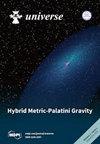论 CCC+TL 宇宙学中的暗物质和暗能量
IF 2.6
4区 物理与天体物理
Q2 ASTRONOMY & ASTROPHYSICS
引用次数: 0
摘要
在膨胀的宇宙中,放宽对耦合常数的时间恒定约束会导致弗里德曼方程包含可解释为暗能量和暗物质的项。当疲劳光(TL)被认为是宇宙膨胀引起的红移的补充时,由此产生的共变耦合常数(CCC+TL)模型不仅与ΛCDM模型一样精确地拟合了Ia型超新星数据,而且还解决了詹姆斯-韦伯太空望远镜观测到的宇宙黎明星系的角尺寸问题。最近的研究表明,该模型符合星系分布和宇宙微波背景(CMB)中的重子声学振荡特征。本文证明了标准ΛCDM模型中的暗能量和暗物质并不是任意的,而是可以从基于狄拉克1937假说的CCC方法中推导出来的。在ΛCDM和CCC+TL模型中,与暗物质和暗能量相关的能量密度大致相同。然而,新模型中的临界密度只能解释宇宙中的重子物质,这就引起了如何解释需要暗物质的观测结果的问题。因此,我们分析了结构形成的一些关键参数,并展示了在没有暗物质的 CCC+TL 情景下,这些参数会受到怎样的影响。这需要重新考虑暗物质的替代方案,以解释引力约束结构的观测结果。该模型与 CMB 功率谱、BBN 元素丰度以及其他关键观测结果的一致性还有待确定。本文章由计算机程序翻译,如有差异,请以英文原文为准。
On Dark Matter and Dark Energy in CCC+TL Cosmology
Relaxing the temporal constancy constraint on coupling constants in an expanding universe results in Friedmann equations containing terms that may be interpreted as dark energy and dark matter. When tired light (TL) was considered to complement the redshift due to the expanding universe, the resulting covarying coupling constants (CCC+TL) model not only fit the Type Ia supernovae data as precisely as the ΛCDM model, but also resolved concerns about the angular size of cosmic dawn galaxies observed by the James Webb Space Telescope. The model was recently shown to be compliant with the baryon acoustic oscillation features in the galaxy distribution and the cosmic microwave background (CMB). This paper demonstrates that dark energy and dark matter of the standard ΛCDM model are not arbitrary but can be derived from the CCC approach based on Dirac’s 1937 hypothesis. The energy densities associated with dark matter and dark energy turn out to be about the same in the ΛCDM and the CCC+TL models. However, the critical density in the new model can only account for the baryonic matter in the universe, raising concerns about how to account for observations requiring dark matter. We therefore analyze some key parameters of structure formation and show how they are affected in the absence of dark matter in the CCC+TL scenario. It requires reconsidering alternatives to dark matter to explain observations on gravitationally bound structures. The model’s consistency with the CMB power spectrum, BBN element abundances, and other critical observations is yet to be established.
求助全文
通过发布文献求助,成功后即可免费获取论文全文。
去求助
来源期刊

Universe
Physics and Astronomy-General Physics and Astronomy
CiteScore
4.30
自引率
17.20%
发文量
562
审稿时长
24.38 days
期刊介绍:
Universe (ISSN 2218-1997) is an international peer-reviewed open access journal focused on fundamental principles in physics. It publishes reviews, research papers, communications, conference reports and short notes. Our aim is to encourage scientists to publish their research results in as much detail as possible. There is no restriction on the length of the papers.
 求助内容:
求助内容: 应助结果提醒方式:
应助结果提醒方式:


